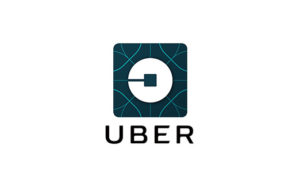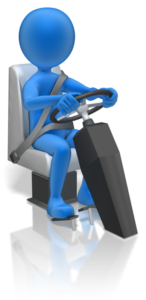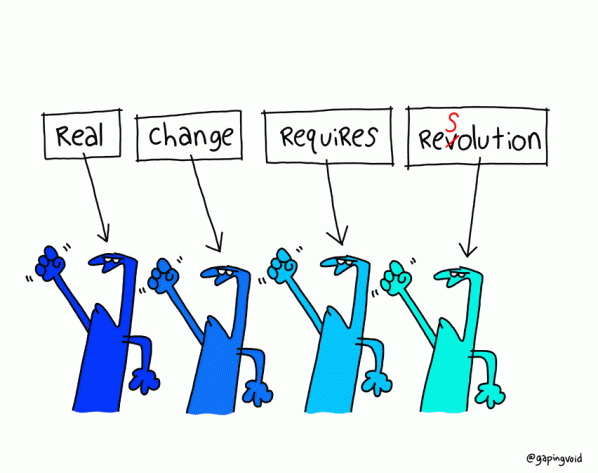Its Time for an Integrated Disruption of Transitions in Care!
Last month I wrote about Transitions in Care from the lens of quality, published in early April both here and in HQO’s QI Forum called Quorum. The article described what prevents transitions from happening smoothly, and highlighted some solutions, both technical and non, that have made hand-overs somewhat easier.
some solutions, both technical and non, that have made hand-overs somewhat easier.
Yet, as a family doctor, I struggle with the need for more. Problematic transitions are largely a human issue, not one that is completely solved by technology. They are poorly integrated and rarely serve either the patient or their provider. It might help to explain the experience of a family doctor or primary care nurse in this case, describing what it’s like moving people between different healthcare silos when all we want is the right thing to happen for their care.
So what is a suitable analogy for how it feels moving a patient from my clinical care to another part of the health care system?
It is much like the experience of a parent who is trying to get one of his teenaged kids to basketball practice. In this scenario, as a family physician, I am the parent. My patient is the teen. If I am not abl e to drive her to the practice myself, one option would be to call a taxi to get her to her destination. Here, the taxi is a proxy for any moving part of the health care system, from a referral to another provider, to obtaining homecare service access, to getting a patient into hospital for surgery.
e to drive her to the practice myself, one option would be to call a taxi to get her to her destination. Here, the taxi is a proxy for any moving part of the health care system, from a referral to another provider, to obtaining homecare service access, to getting a patient into hospital for surgery.
When I put my child into a taxi I want her to arrive safely and without incident, and there is a certain level of trust that she will. Thankfully, usually this is the case. But this trust comes without knowing virtually anything about the journey. The route is undefined. The taxi may take highways or poorly marked back roads. There is no easy way to track where it has been or is going. There is a vague confidence that the driver is probably competent, but really I have no insight into his safety record, driving skills or even how clean his car is. My child climbs in and we say goodbye knowing that almost certainly she will be fine, but still there is a background level of uneasiness and worry about the journey until I am aware that she has arrived in one piece.
R ecently, though, a revolution has happened in the taxi industry. It has undergone a disruptive transformation and changed dramatically over the past five years. It has been revolutionized by Uber.
ecently, though, a revolution has happened in the taxi industry. It has undergone a disruptive transformation and changed dramatically over the past five years. It has been revolutionized by Uber.
In healthcare, our discomfort with transitions must change. We have to disrupt the process.
Putting my child into an Uber sedan en-route to her destination is very similar to a medical hand-off. With either a taxi or Uber, a relative stranger is being entrusted with my daughter’s care. She will likely get to her destination either way, but in the “Uberfied” world this happens with much  more transparency. I make a single simple request for service in a very convenient way, launching the request from a tool with which I run most of my life. (With Uber this is my phone, in medicine this is my EMR.) When I request service I know the license plate number and type of vehicle it is attached to and even something about the driver. There is a picture of him and a rating of his service from previous riders. If I am not confident in him I can even choose another driver. By having access to this information I have begun to build an implicit trust and there is the beginning of a social contract. Also, along the journey, I have line of sight to how long it will be before the car arrives, and after it leaves I can see where my child is on her route. I am even alerted as to when she arrives safely, and if there are any worries or concerns I can text or call the driver at any time.
more transparency. I make a single simple request for service in a very convenient way, launching the request from a tool with which I run most of my life. (With Uber this is my phone, in medicine this is my EMR.) When I request service I know the license plate number and type of vehicle it is attached to and even something about the driver. There is a picture of him and a rating of his service from previous riders. If I am not confident in him I can even choose another driver. By having access to this information I have begun to build an implicit trust and there is the beginning of a social contract. Also, along the journey, I have line of sight to how long it will be before the car arrives, and after it leaves I can see where my child is on her route. I am even alerted as to when she arrives safely, and if there are any worries or concerns I can text or call the driver at any time.
When comparing the taxi and Uber scenario, it is interesting to note that at times it is even the same driver and same car being used by both services.
So what is different? It’s the integrated process.
In an integrated and well managed system of transitions, as a physician I would have access to knowledge about the journey, the vehicle and the driver. There would be excellent communication between all the people who are touching my patient. This would have a personal feel and sense of connection. The drivers/health care workers I interact
 with would feel proud of their work, and be accountable to our shared patient with the hope of being highly rated. There would be a single step to ordering, contracting, handing off, tracking and rating the service, both by the patient and the physician. The patient would be the centre of the transaction, trusting the process from start to finish. He would feel comfortable integrated into a strong and dynamic network.
with would feel proud of their work, and be accountable to our shared patient with the hope of being highly rated. There would be a single step to ordering, contracting, handing off, tracking and rating the service, both by the patient and the physician. The patient would be the centre of the transaction, trusting the process from start to finish. He would feel comfortable integrated into a strong and dynamic network.
So what does primary care need to improve the experience of navigating and advocating for our patients? What would integration look like?
- We need to be able to trust that our patient was handed off warmly from place to place or person to person
- We must have reliable, trackable and dependable service delivery
- There should be a sense of what, when and where care is happening and by whom
- There would be seamless connectivity and communications between all providers
- Trust would be both implicit and explicit, knowing that others value the relationship they have with my patient as much as I do
- We would hold the system, providers, ourselves and our patients appropriately accountable for their aspects of the journey
- Data to drive information, knowledge and insight would be in real time and available when/where it is needed at the point of care
- The entire set of transactions would be based on the best interests of improving our patient’s condition, not accepting “buffing and turfing” or “passing the buck” onto the next provider to absolve our responsibility
- Patients would be empowered with their own data to help steer the ship as they are the ones most involved in their care for the 99.9% of the time we are not with them
- Systems and policies would be in place that maintain and enhance relationships, not disrupt them. And all relationships in an integrated team would be valued.

This is not simple work. But it’s important to me as a family physician. We must ask ourselves how the health care system could be more disruptive in creating transitions to ensure that not a single person falls between the cracks. Modernization of integrated transitions in care is no longer an option. It is mandatory, and we should settle for nothing less.


18 Replies to “Its Time for an Integrated Disruption of Transitions in Care!”
Thanks, Darren, for a good blog on such an important topic. I wondered what the baseball practice had to do with the topic, until you added the real issue, the taxi/Uber analogy. Nice way to peak somebody’s curiosity! I submit that the last three bullets are the most important, but possibly also the most difficult elements in care transition. I also wonder whether there is anything in the research/literature of handover in hospital/acute care settings (my world) that primary care use for the practical implementation of transition. Just a thought, no need to answer. Thanks again! – Johny
Johny… thanks so much for commenting! Appreciate the read only 5 minutes after it was posted!! Will need to look at that research… lots of anecdotal tales, mostly not happy ones. If you find anything, let me know!
I like the analogy, integration doesn’t need to be all that difficult. The trick is to find a simple way to transport the data. I advocate for the patient to be the holder, custodian and delivery agent of their data. Pick a standard format (apple HealthKit) and get the EMRs to ingest, modify and return the data to the patient. You can then rest easy that your teenage will arrive safely ?
Dave, thanks so much for the comment. I agree with you completely about patients having access and control over their data. If they choose not to hold it themselves (too frail, too sick, not able), I am very comfortable with being a steward on their behalf and would love to see them able to access it any time from any place, including when I transition them to another part of the system!
MyChart.com is a great way for patients to have access to their own records. It’s available at TOH in Ottawa and at the hospitals in Toronto.
but..we also need to factor in paid time for health care professionals to actually pick up the phone and call(or text) the other members of the care team.
Agreed Ann. It doesn’t need to be fancy technology. Even a phone call will do! Thanks for reading and for the reply!
So much of what is needed is based on developing trusting relationships with health and social care providers across sectors and basic communication with each other. Trust among health care providers improves patient care.
Absolutely true Sue. Trust starts with being trustworthy! And is the backbone of all good relationships. Thanks for the comment!
Timely analogy, Darren. Although I hope we can do a little better than Uber. If I can adjust your analogy a little, I would suggest that your/our EMR is not the vehicle and will likely never be. Our EMRs are more like the garage….lots of stuff stored there but silo’d. What we need are innovate people to provide Uber-like services driving vehicles (secure communications…my bias, as you know) that are inspected and certified to transport our precious cargo/people/health data. The drivers may change and the vehicles may be tasked to different functions, but the big difference between now and the future is, as you suggest, that people can call up their own ‘rides/delivery’ around their own needs, schedule, costs, destinations. But whatever vehicle and whichever service provider should preferably be using a properly vetted vehicle. Great topic.
Great points Norm! No biases apparent to me!! 🙂
So many great points in this post. But I’d like to focus on one: “Patients would be empowered with their own data to help steer the ship as they are the ones most involved in their care for the 99.9% of the time we are not with them.” I agree with this wholeheartedly! We used a patient portal for 3 years with our last EMR at my office and our patient surveys showed that other than the family doctor/staff-patient relationships, the portal was regarded as the favourite feature of our office. Since moving to a new EMR, our patients are clamoring for a new portal. We are in the process of testing one and look forward to rolling it out to all of our patients. And now being on the other side of it – helping a friend at a hospital with a patient portal, I can’t describe the feeling of empowerment that the patient has being able to review results/notes relating to her care. She also gives trusted family members permission to view her results and consult notes and help make sure that she is receiving excellent care. In my opinion, the time has come for all of us to empower all of our patients. I believe in it so strongly that I will be trying to convince as many health care professionals as possible by speaking at eHealth 2017 in Toronto. On June 6th in the 1 pm session “Personal Health Record (PHR) Storms Across Canada”, I will be one of four speakers who will present about PHRs. My talk is titled “Perks and Pitfalls of Patient Portals” – hope to see readers of your blog there!
I had the same experience in my office when we had the PSS/CMA MyDoctor portal. It was amazing. Patients need access; we can figure out how to give it to them. I hope to be at your panel!! Thanks for the comment!
Hi Darren,
your story is a good analogy. I have been thinking a lot about transitions as our referral process is turning into more of a nightmare. in this day and age it might take the Uber 12-18 months to get to its destination. Meanwhile, the engine needs fixing, the gas tank needs filling and the driver and passenger need nutrition/hydration!
jean
Jean! Thanks for the read and extending the analogy to obvious places I did not! Fantastic!
and the Uber has to bring back the passenger safely…. not sure what happens to all those Ubers who never seem to make it back to us–. our current frustrations lie with sending out specialist referrals and not getting timely appointments AND with not getting any note back from the specialist. Who controls the rules of the road? it seems that the specialists get to dictate all kinds of policies on their end, which is definitely contributing to the traffic jam. we probably need some bike lanes and pedestrian walkways. just like the transit system = a multifaceted approach is necessary! like you said a disruptive approach is required as it is a complex, systemic issue.
just a question- Who decided that if a family doctor makes a referral to a specialist that the created appointment is sent back to the doctor to alert the patient. In this day and age it all seems so cumbersome and time consuming. Why is it not possible that once the referral is sent, that the patient then contacts the specialist’s office directly to schedule an appointment? I have already sent the travel plan in—- why can’t the customer do the follow up…… ( i think i am reaching here)
Is there an OMA working group looking at this? i thought I saw it somewhere but can’t remember. jean
Jean … so many good points! And inefficiencies are all across the system. Provincial eReferral with a patient portal would help … like Consult Loop or Ocean have. Not sure if an OMA working group but if not then suggest one!!
Darren you’ve done a great job documenting the concepts in a manner we can all appreciate.
Hey Kevin ! Thanks for that and thanks for reading!